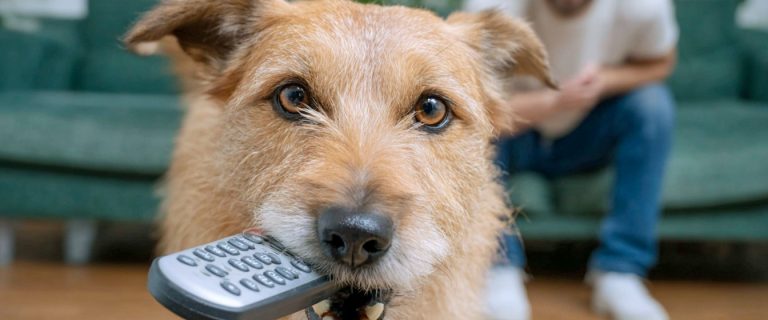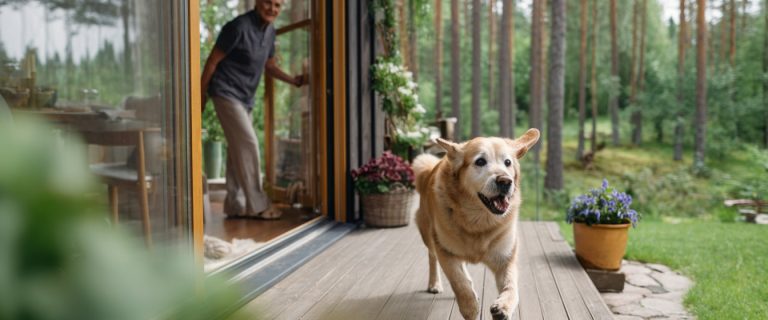Should you crate train your dog? According to many experts, yes, you should!
The word “crate” often carries negative associations, almost as if a crate is jail for your dog, something that no one wants for their furry best friend. But a crate can actually be a comforting place for your pup and if introduced correctly, can be a space that your pup will come to know and love.
Most veterinarians and trainers recommend crate training dogs from a young age. It’s an essential part of housebreaking puppies as well.
“We recommend crate training every dog because you never know what’s going to happen in the future,” says Christine Kroh, intake coordinator at Beagles to the Rescue.
Additionally, dogs that are crate trained are able to cope with potentially stressful situations better as well. For crate-trained dogs, the crate can be a safe space where they can go to rest and recover from surgery, or to hide away from scary situations such as fireworks or unfamiliar guests.
“If the dog’s freaking out, they think: ‘I can go hide in my crate and it’s safe here and nobody’s gonna bother me.’ That helps them out for their lifetime,” explains Kroh.
When set up properly, your pet will love their crate and enjoy having a space that’s all their own.
Introducing your dog to a crate can be stressful at first, but with a little work and a lot of patience, you can help your furry friend understand the benefits of having a space of their own.
Wondering how to crate train a dog? Here are some ways to help make this dream a reality along with some crate training mistakes you’ll want to avoid.
Crate Training: What You Should Know
If you are looking to make a crate a safe space for your pup, then you should consider crate training; training being the key word here. You shouldn’t put your dog in a crate if he hasn’t been properly trained. Doing so will only make your dog view the crate as a bad place and not a place of comfort. If your dog isn’t properly crate trained then they will not use the crate as their safe place. You should also be careful not to use the crate as a place of punishment or else your pup will view the crate with negative associations.
Here are some steps you might consider using when it comes to crate training your dog:
- Introduction – Introducing your dog to the crate can take a couple of weeks depending on your dog. It is important to allow some time for your dog to get used to the crate during this stage. Bring it in the house and let your dog get used to being around it. Different dogs will take different amounts of time to warm up. Resist forcing your dog to go inside, but rather encourage him to go in and offer treats while inside. One of the more common crate training mistakes is rushing this process, but take it slow and give your dog time to adjust.
- Feed Meals Inside – Once your pup has gotten used to the crate being around, you should start feeding him meals inside. Meals are a highlight of every dog’s life and will help your dog to form positive associations about the crate. Start by feeding the meal close to the crate and eventually move the bowl inside. After a while, start closing the door for a short period of time while he eats. Be sure to take it slow.
- Work Up to Longer Periods – Once your pup can eat a meal inside the crate with the door closed and not panic, you can start working towards closing the door and leaving him there for longer periods of time. Start by leaving him in for only a few minutes and work up to longer periods of time. Always be sure to end on a positive note and with plenty of rewards.
Getting Started: How to Crate Train a Dog
When it comes to how to crate train a dog from the start, be sure to make it a positive experience. Keep the door open, offer treats when inside, move eating time to the crate, and keep an overall positive attitude about it. Never use the crate as a source of punishment. This will help lay the groundwork for making the crate a positive and safe space in your dog’s mind.
Here is what the process of setting up a safe space for your pup will look like:
- Choose the Right Crate
There are a number of different styles of crates that you can choose from. When you choose a crate, you want to choose one that is large enough for your pup. He should be able to stand and turn comfortably.
A wire crate option can be great to allow for air to flow freely, but some fearful dogs may be nervous in a wire crate, where they can see the outside world but can’t interact with it. If your pup prefers a bit more privacy, you can always cover all the sides except the door to help create a cozy space where your pup will feel safe and secure.
- Make It Comfortable
You want your pup’s space to be comfortable, but you should also be sure that you keep it safe! If your dog is prone to tearing up toys and blankets then you might want to purchase a solid bed that will provide some comfort without making the space unsafe. Keep your dog’s preferences in mind; do they prefer soft spaces to sleep, or are they more comfortable on hard surfaces? Make their crate personalized to their idea of comfort, not yours, and always be sure to keep safety in mind.
- Keep It Fun and Positive
When your dog is getting used to the crate, consider playing games or offering special treats inside the crate. This is especially important as you work through crate training, but it is also important to keep in mind as your dog gets more comfortable. The crate is meant to be a safe space for your pup to go and relax, not be sent when he has done something wrong. Keep it fun and positive to help create that fun and safe space.
- Offer Rewards
Offering rewards is also a great way to help boost your pup’s positive association with the crate. Once your pup gets used to the crate, the rewards won’t need to come as frequently, but when you are first starting, feel free to offer rewards, especially if he goes in the crate on his own. Keep it fun and positive to help your dog associate those things with his crate.
- Be Patient and Move Slowly
Don’t rush the process. For most dogs, crates are something new. While many come to love their crates, it can be a scary process when they first start getting used to them. Don’t rush the process or force your dog into the crate as this will undo any positive steps you have taken. Take it slow and let your dog move at their own pace.
Eventually, they will come to enjoy having their own quiet place. Remember, this is all new to your dog, be patient as they learn that this is a safe space. Don’t force them to participate, take it slow, remain positive, and be patient.
- Take Care With Puppies
For very young puppies, it’s important to ensure that you don’t leave them in the crate for extended periods of time. Young puppies can become very distressed. A puppy yapping for a short period of time is okay. A puppy crying for hours on end is not.
Remember, the crate is supposed to be a safe space for your pup. Keep things light and positive, and they will grow to love it. If it’s stressful, they will learn to hate it, so take them out before they get too upset.
- Establish Boundaries
Finally, it is important that you keep your dog’s crate a safe space. Don’t allow other animals or people to bother your dog while they are in there. Respect their boundaries and allow them to have their space. By setting boundaries you will help your dog to see this as their safe space and escape for when things become too much.
While a crate is often thought of as a good place to keep pups while they are young, learning to potty train, and mastering the ropes of being a good boy or girl, your dog can grow to love their crate and often will start to retreat to their crate on their own for comfort. Take the time to introduce a crate to your dog to help give them a space that’s all their own: for life.


